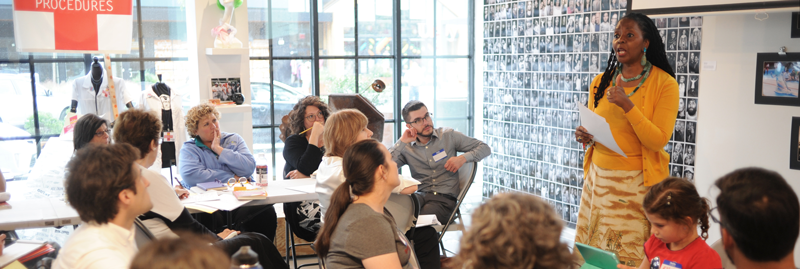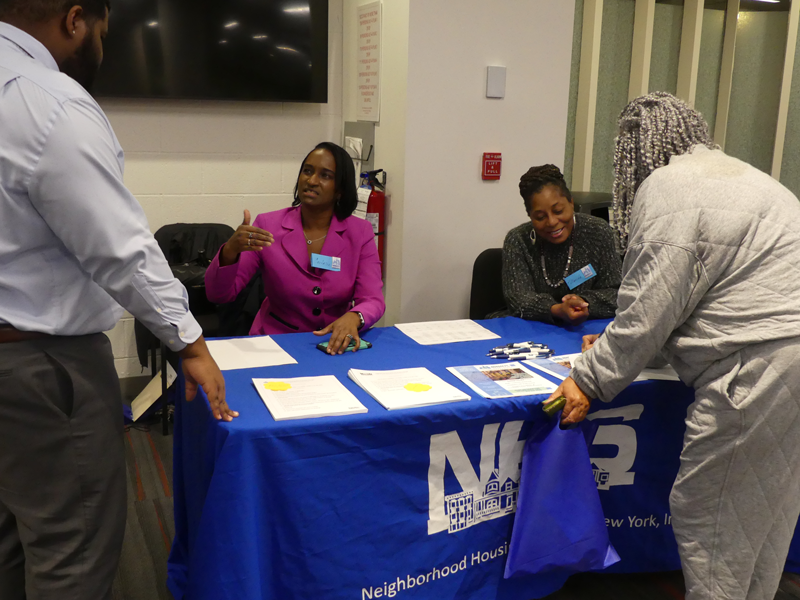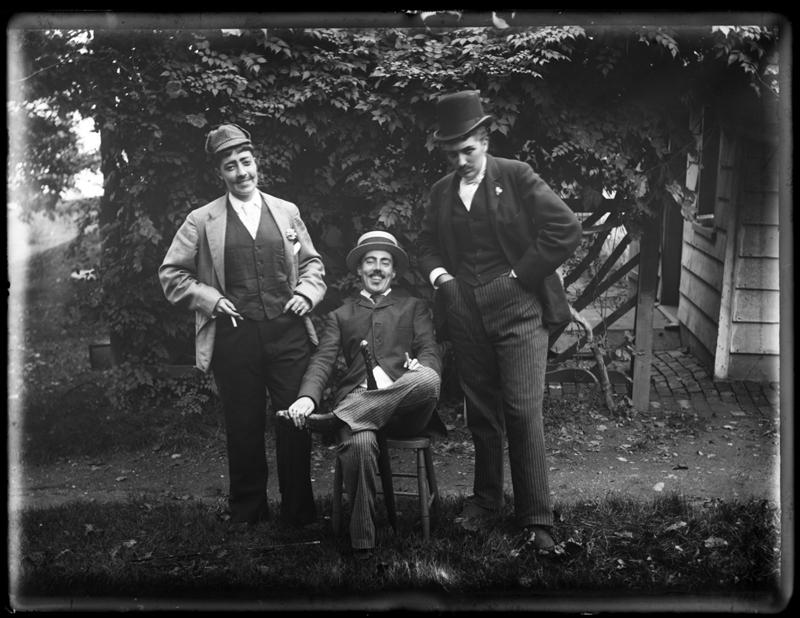
Visited by the Italian explorer Giovanni da Verrazzano in 1520, named “Staaten Eylandt” by Dutch sailors aboard Henry Hudson’s ship in 1609, and “Richmond” by the British in 1664, Staten Island has a rich history and a richly textured story to tell today.
The Trust—as we do in all eight counties we serve—turns altruism into action across the Island, connecting generations of caring New Yorkers with nonprofits improving the quality of life for all.
Staten Island is a singular urban landscape with sandy beaches along its eastern shore and miles of verdant hiking trails in its central Greenbelt. It is a borough with thousands of single-family homes, several public housing developments, and communities of immigrants, including the largest population of Liberians outside of West Africa.
Over the years, The Trust co-funded several projects with the Staten Island Foundation to help make the borough a healthy, thriving community. Laura Jean Watters, the Foundation’s executive director, said people from outside the Island often see it as a homogeneous, middle-class community, but Trust staff “look past the stereotype.”
“Receiving funding from The Trust is only part of the benefits for an organization,” Watters added. “Grantees are going to get engagement and enthusiasm from the staff and really have a thought partner. When somebody from The Trust calls, you answer. You want to be part of their work, which is far reaching and has a solid reputation.”

Better jobs and homes
Since good-paying jobs are the foundation of a healthy economy, The Trust has helped Island residents through the College of Staten Island’s Office of Workforce Development and Innovation, an employment hub for jobseekers. The College is partnering with local nonprofits to find eligible scholarship candidates looking to pursue careers in growing fields such as technology, healthcare, and clean energy.
Because much of the Island’s housing stock is aging, energy inefficient, and sometimes even a threat to the health of its occupants, upgrading older homes is a win-win for residents and the environment. Neighborhood Housing Services of Staten Island works with low-income homeowners through its Healthy Homes Initiative. In addition to organizing workshops, the group offers home inspections that identify hazardous and unhealthy conditions, including triggers for asthma. Owners are then connected with vetted contractors and, if necessary, healthcare providers.
Bolstering arts and culture
For decades, The Trust has helped strengthen Staten Island’s important arts and culture nonprofits. Recognizing that the borough’s demographics were diversifying, The Trust supported the county’s arts council, Staten Island Arts, to create a series of workshops to prepare arts groups to better reach and serve new populations. Groups identified ways to welcome new audiences, including people with disabilities and growing immigrant communities.
The workshops were followed up with seed money to test new approaches. The Staten Island Children’s Museum, for example, created a multiracial parents advisory council and revised its marketing materials to be more welcoming. Historic Richmond Town, a living-history village and museum, searched its archives for objects that told the story of African Americans and reconfigured its arts education curriculum to be more inclusive.
“This program allowed us to build a cohort and build community,” said Gena Mimozo, deputy director and grants administrator of Staten Island Arts. “We were able to support folks in the trenches doing really difficult work around social justice issues—and that fight continues today.”
The program was an eye-opening experience for staff and audiences at many of the predominantly white arts institutions, Mimozo said. “There was a lot of learning about other cultures, other communities, as well as learning about our own identities and positions in the world.”
A green urban environment
While the Island’s population boomed after the 1964 opening of the Verrazzano Bridge—the world’s longest suspension bridge at that time—the borough retains reminders of its rural past, and The Trust has helped cultivate its natural green spaces.
In 1948, the first scowload of garbage arrived on the Island’s western shore for burial at the Fresh Kills saltwater wetlands. The infamous Fresh Kills Landfill became the sole repository for the city’s daily 29,000 tons of garbage, finally closing in 2001. The city then announced plans to turn what Islanders universally called “the dump” into a park with both passive and active recreation areas. The Freshkills Park Alliance used a Trust grant to create a plan to guide development and build an audience for the park as it opens in phases and undergoes 30 years of remediation.
The Trust also worked with the Greenbelt Conservancy, which manages 2,800 acres of interconnected public and private green areas in the middle of the Island. The Greenbelt is an amalgam of city-owned parks and privately owned green spaces, including a Boy Scout camp, a golf course, and a cemetery. The Trust helped the Greenbelt staff grow and assess native plants for potential use in remediating “brownfields,” former industrial sites where chemicals had contaminated the soil. The plants were tested to see if they could survive year after year as they naturally drew contaminants out of the ground.
A quick response to Sandy
The Island’s eastern residential communities, which were built on former saltwater marshes, were devastated by Superstorm Sandy flooding.
The Trust immediately supported emergency relief efforts that provided healthcare and food via Community Health Action of Staten Island and Project Hospitality. To prepare for the next storm, The Trust helped Nonprofit Staten Island bring together local agencies to create the borough’s first federally recognized disaster response network and address any gaps in preparedness.
Sharing a diverse history
The borough is home to one of the the country’s oldest continuously inhabited free Black communities: the Sandy Ground section in Rossville. The Trust has helped preserve that history and advance a promising partnership to digitize the genealogical records of African Americans on Staten Island. The Richard B. Dickenson Chapter of the Afro-American Historical and Genealogical Society, the Staten Island Museum, and Frederick Douglass Memorial Park created a publicly available digital archive. The groups held “transcribe-athons,” where volunteers read handwritten pages and entered them into the growing digital records. There have been 10,000 visitors to the Staten Island Museum’s online archive and 900 to the Frederick Douglass Memorial Park site.

The Trust also helped the Island bring LGBTQ history out of the closet. A grant to the Alice Austen House came at a “really pivotal moment,” said the museum’s executive director, Victoria Munro. The north shore former home of the photographer Alice Austen had just amended its national landmark status to include its significance in LGBTQ history.
The House embarked on a reframing of its programming and marketing to more fully tell the central story of the lesbian relationship between Austen and her longtime partner, Gertrude Tate.
“We went from being a historic house to being at the forefront of LGBTQ interpretation at historic sites,” Munro said, adding that the grant “enabled us to make partnerships that have been really lasting” with LGBTQ groups and institutions on the Island and citywide.
“The grant was all about visibility and that’s something we really achieved,” said Munro.
Building the next generation of leaders
The Trust has played a role in nurturing tomorrow’s leaders from across the Island’s diverse communities. For example, African Refuge started “Letting Go and Letting Youth Lead” to provide training on organizing, base-building, writing, speaking publicly and with the media, and health disparities, as well as academic and healthcare support for Black youth on Staten Island.
Emmah Sackie, a tenth-grade African Refuge participant, said, “I have found my voice. I’ve learned to stand up for what I believe and debate with a lot of information and evidence. When I am vocal I feel confident that it’s going to make a difference. The world needs my voice because what I have to say does matter. Even though the world may discriminate against African American women, it won’t stop me from reaching my goals.”
Yesterday, today, and tomorrow
More than twice the size of Manhattan, Staten Island is an integral part of the city’s history and an invaluable part of today’s metropolitan region. The Trust’s past and present donors have supported the Island’s nonprofits as they deliver assistance to those who need it the most.
Four ways you can bring a brighter future to Staten Island:
- Be an influencer! Share this story with friends and family and talk about it.
- Donate directly or through your donor-advised fund to any of the nonprofits found in this story, or others like them.
- Give to our Community Needs Fund and we’ll find charities to meet the needs of the moment on Staten Island and in the rest of the city.
- Leave a legacy by establishing a permanent fund. Contact giving@thenytrust.org